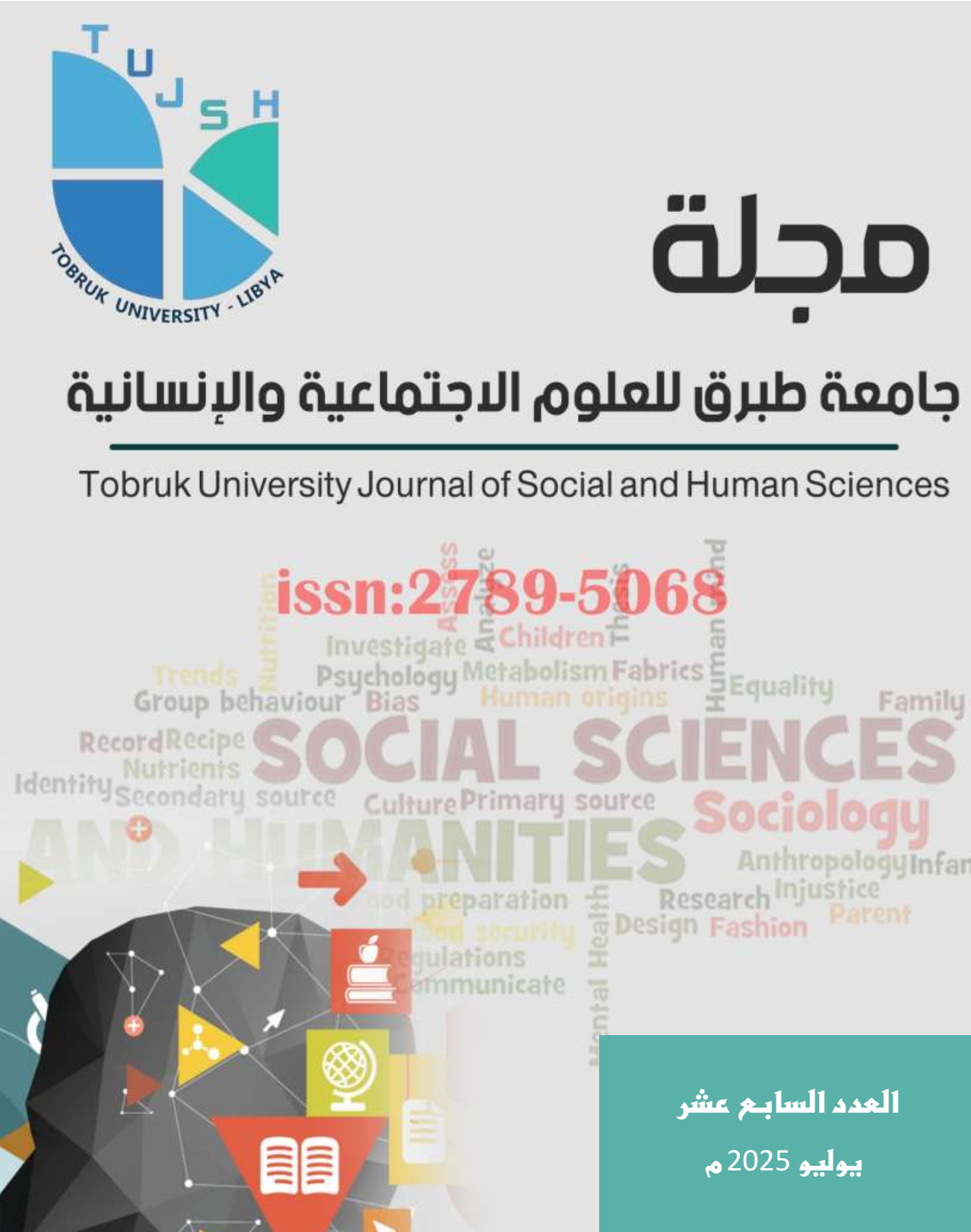تطور الفكر البدائي وإرهاصات الثورة الزراعية في عصور ما قبل التاريخ
دراسة تحليلية في التحول العقلي والسلوكي للإنسان قبل العصر النيوليتي
DOI:
https://doi.org/10.64516/zqzg2p52الكلمات المفتاحية:
الثورة الزراعية، الزمن الدائري، العقل الأسطوري، الفكر البدائي، المعرفة البيئيةالملخص
يتناول هذا البحث تطور الفكر البدائي وإرهاصات الثورة الزراعية في عصور ما قبل التاريخ من خلال دراسة تحليلية للتحول العقلي والسلوكي للإنسان قبل العصر النيوليتي. يبرز البحث أهمية الفكر الأسطوري والتفكير المجازي في تشكيل وعي الإنسان البدائي، حيث كان يتفاعل مع الطبيعة ككيان حيّ متداخل بالأرواح والرموز، ما شكّل الأساس لنشوء الأنظمة الدينية والرموز الاجتماعية. كما يناقش البحث مفهوم الزمن الدائري والذاكرة الجماعية التي ساعدت في بناء نموذج زمني دوري مرتبط بالطقوس والمواسم، وهو ما كان ضروريًا لفهم الدورات الزراعية. علاوة على ذلك، يسلط البحث الضوء على تراكم المعرفة البيئية التقليدية ودور الملاحظة الدقيقة للطبيعة في تمهيد الأرضية الذهنية للزراعة، بالإضافة إلى تحول الإنسان من كائن متنقل إلى كائن مستقر مرتبط بالمكان والملكية. هذه التحولات الذهنية والرمزية كانت جوهرية في تمهيد ظهور الثورة الزراعية، التي لم تكن قفزة مادية فجائية، بل نتيجة تراكم معرفي وثقافي طويل الأمد.
المراجع
1. Assmann, J. (2011). Cultural Memory and Early Civilization: Writing, Remembrance, and Political Imagination. Cambridge University Press.
2. Bell, C. (1992). Ritual Theory, Ritual Practice. Oxford University Press.
3. Bellwood, P. (2005). First Farmers: The Origins of Agricultural Societies, Oxford: Blackwell,.
4. Berkes, F. (2012). Sacred Ecology (3rd ed.). Routledge.
5. Bisson, M. S. (1996). The "Venus" Figurines: Texts, Images, and Meanings. Antiquity.
6. Burkert, W. (1985). Greek Religion: Archaic and Classical. Harvard University Press.
7. Campbell, J. (2008). The Hero with a Thousand Faces. New World Library.
8. Cauvin, J. (2000). The Birth of the Gods and the Origins of Agriculture. Cambridge University Press. (pp. 105–140)
9. Clark, J. G. D. (1975). The Mesolithic Settlement of Northern Europe. Cambridge University Press.
10. Clottes, J. & Lewis-Williams, D. (1998). The Shamans of Prehistory: Trance and Magic in the Painted Caves, Harry N. Abrams.
11. Diamond, J. (1997). Guns, Germs, and Steel: The Fates of Human Societies. W. W. Norton.
12. Eliade, M. (1958). Patterns in Comparative Religion. Sheed & Ward.
13. Eliade, M. (1959). The Sacred and Profane: the The Nature of Religion (W. R. Trask, Trans.). Harcourt, Brace & World.
14. Eliade, M. (1963). Myth and Reality, Harper & Row.
15. Eliade, M. (1978). A History of Religious Ideas, Vol. 1, University of Chicago Press
16. Gamble, C. (1999). The Paleolithic Societies of Europe. Cambridge University Press.
17. Gamble, C. (2007). Origins and Revolutions: Human Identity in Earliest Prehistory. Cambridge University Press.
18. Gero, J. M. & Conkey, M. W. (1991). Engendering Archaeology: Women and Prehistory, Blackwell,.
19. Gimbutas, M. (1989). The Language of the Goddess. Harper & Row.
20. Halbwachs, M. (1992). On Collective Memory (L. A. Coser, Ed. & Trans.). University of Chicago Press.
21. Hayden, B. (1995). “Pathways to power: Principles for creating socioeconomic inequalities.” In Foundations of Social Inequality, eds. Price & Feinman, New York: Plenum,
22. Hodder, I. (1990). The Domestication of Europe: Structure and Contingency in Neolithic Societies. Blackwell.
23. Hodder, I. (2006). The Leopard’s Tale: Revealing the Mysteries of Çatalhöyük, Thames & Hudson,.
24. Hodder, I. (2010). Religion in the Emergence of Civilization: Çatalhöyük as a Case Study. Cambridge University Press,.
25. Hoskin, M. (2001). Tombs, Temples and Their Orientations: A New Perspective on Mediterranean Prehistory, Ocarina Books.
26. Ingold, T. (2000). The Perception of the Environment: Essays on Livelihood, Dwelling and Skill, Routledge,.
27. Larson, G., & Fuller, D. Q. (2014). The Evolution of Animal Domestication. Annual Review of Ecology, Evolution, and Systematics. 45, 115–136.
28. Legge, A. & Rowley-Conwy, P. (2000). “The exploitation of animals.” In Archaeology of the Near East, ed. Kuijt, I.,.
29. Leick, G. (1994). Sex and Eroticism in Mesopotamian Literature. Routledge.
30. Lévi-Strauss, C. (1966). The Savage Mind. University of Chicago Press.
31. Lewis-Williams, D. (2002). The Mind in the Cave: Consciousness and the Origins of Art, Thames & Hudson.
32. Mithen, S. (1996). The Prehistory of the Mind: The Cognitive Origins of Art, Religion and Science. Thames & Hudson.
33. Nazarea, V. D. (1999). Ethnoecology: Situated Knowledge/Located Lives. University of Arizona Press.
34. Renfrew, C. (2007). Prehistory: The Making of the Human Mind. Modern Library.
35. Renfrew, C. (2007). Prehistory: The Making of the Human Mind. Weidenfeld & Nicolson.
36. Schmidt, K. (2010). Göbekli Tepe – The Stone Age Sanctuaries, Berlin: Ex Oriente.
37. Sherratt, A. (1983). “The Secondary Products Revolution.” World Archaeology. 15(1),.
38. Smith, B. D. (2001). “Low-Level Food Production,” Journal of Archaeological Research, 9(1),.
39. Soffer, O., Adovasio, J. M., & Hyland, D. C. (2000). The "Venus" Figurines: Textiles, Basketry, Gender, and Status in the Upper Paleolithic. Current Anthropology, 41(4), 511–537.
40. Vernant, J.-P. (1983). Myth and Thought among the Greeks. Routledge & Kegan Paul.
41. Watkins, T. (2011). “New light on Neolithic revolution in southwest Asia.” The Review of Archaeology.
42. White, R. (2000). Prehistoric Religion: Myth, Ritual, and Social Change. University of California Press.
43. Zeder, M. A. (2006). “Archaeological approaches to documenting animal domestication.” In Journal of Archaeological Method and Theory, 13(1),.
44. Zohary, D., Hopf, M., & Weiss, E. (2012). Domestication of Plants in the Old World (4th ed.). Oxford University Press.
45. Zvelebil, M. (1996). “The Agricultural Transition in Europe,” in The Origins and Spread of Agriculture and Pastoralism in Eurasia, ed. D. R. Harris, UCL Press,.
46. Zvelebil, M., & Lillie, M. (2000). Transition to Agriculture in Eastern Europe. In T. D. Price (Ed.), Europe’s First Farmers (pp. 57–92). Cambridge University Press.
التنزيلات
منشور
النسخ
- 11-08-2025 (2)
- 11-08-2025 (1)
إصدار
القسم
الرخصة
الحقوق الفكرية (c) 2025 د. خالد آدم أحميدة جاب الله (Autor/in)

هذا العمل مرخص بموجب Creative Commons Attribution 4.0 International License.










